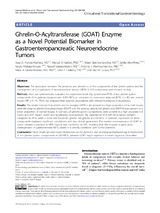Ghrelin-O-Acyltransferase (GOAT) Enzyme as a Novel Potential Biomarker in Gastroenteropancreatic Neuroendocrine Tumors
Autor
Herrera-Martínez, Aura D.
Gahete Ortiz, Manuel D.
Sánchez-Sánchez, Rafael
Alors-Pérez, Emilia
Pedraza-Arévalo, Sergio
Serrano-Blanch, Raquel
Martínez-Fuentes, Antonio J.
Castaño, Justo P.
Luque, Raúl M.
Gálvez-Moreno, M. Ángeles
Editor
Nature.comFecha
2018Materia
Neuroendocrine tumorsBiomarkers
Enzymes
METS:
Mostrar el registro METSPREMIS:
Mostrar el registro PREMISMetadatos
Mostrar el registro completo del ítemResumen
Objectives: The association between the presence and alterations of the components of the ghrelin system and the
development and progression of neuroendocrine tumors (NETs) is still controversial and remains unclear.
Methods: Here, we systematically evaluated the expression levels (by quantitative-PCR) of key ghrelin system
components of in gastroenteropancreatic (GEP)-NETs, as compared to non-tumor adjacent (NTA; n = 42) and normal
tissues (NT; n = 14). Then, we analyzed their putative associations with clinical-histological characteristics.
Results: The results indicate that ghrelin and its receptor GHSR1a are present in a high proportion of normal tissues,
while the enzyme ghrelin-O-acyltransferase (GOAT) and the splicing variants In1-ghrelin and GHSR1b were present in a
lower proportion of normal tissues. In contrast, all ghrelin system components were present in a high proportion of
tumor and NTA tissues. GOAT was significantly overexpressed (by quantitative-PCR (qPCR)) in tumor samples
compared to NTA, while a trend was found for ghrelin, In1-ghrelin and GHSR1a. In addition, expression of these
components displayed significant correlations with key clinical parameters. The marked overexpression of GOAT in
tumor samples compared to NTA regions was confirmed by IHC, revealing that this enzyme is particularly
overexpressed in gastrointestinal NETs, where it is directly correlated with tumor diameter.
Conclusions: These results provide novel information on the presence and potential pathophysiological implications
of the ghrelin system components in GEP-NETs, wherein GOAT might represent a novel diagnostic biomarker.

